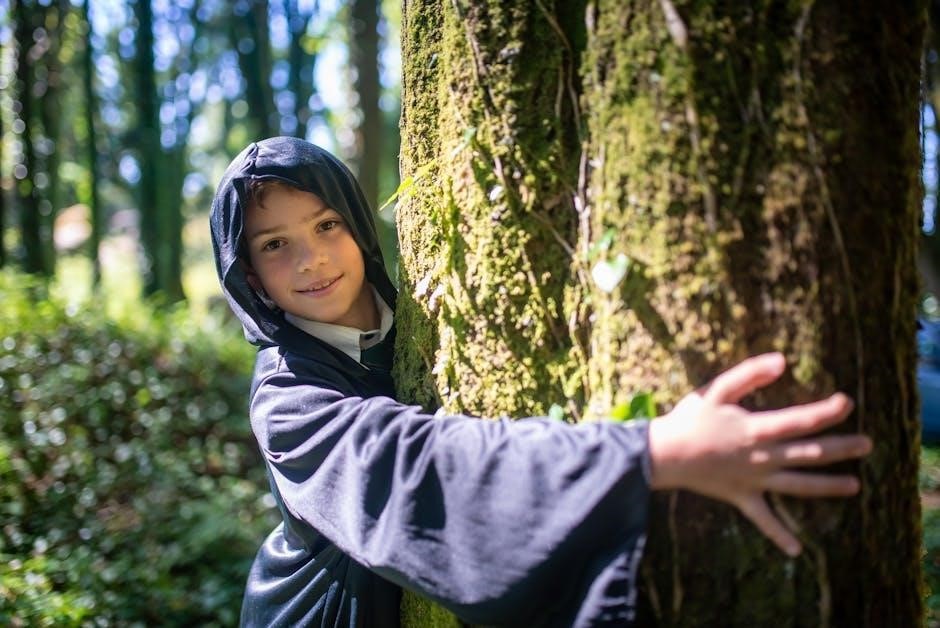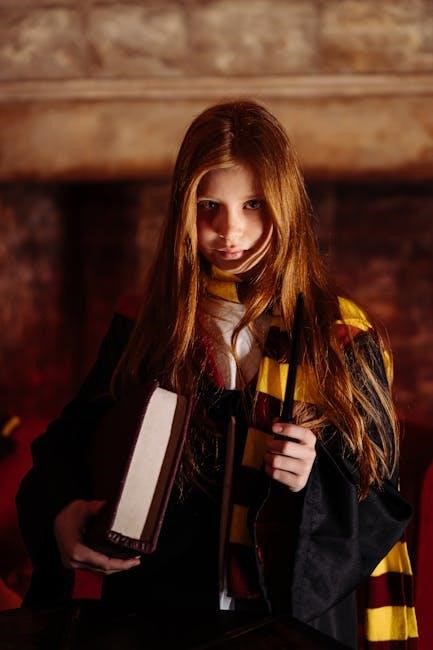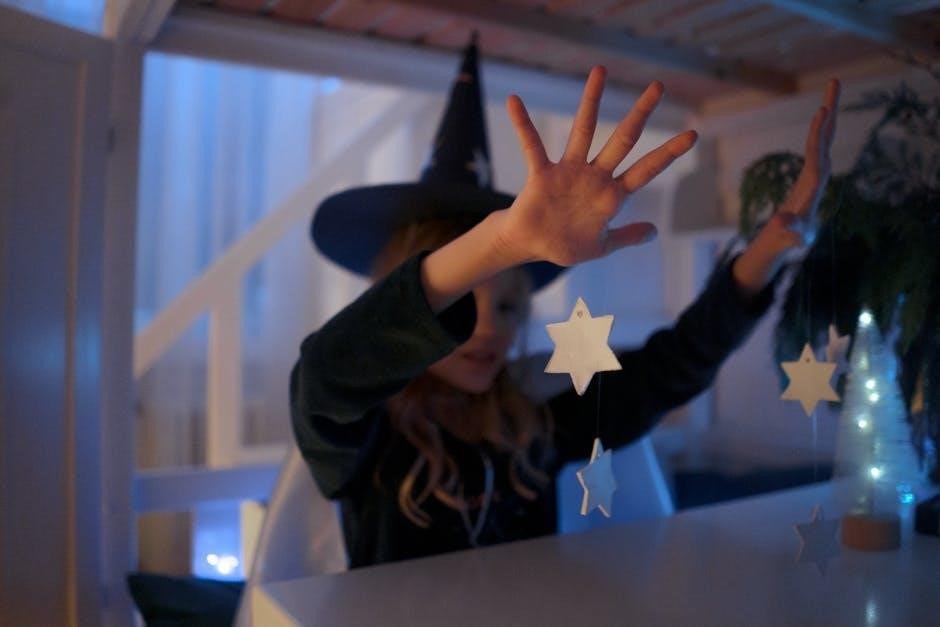The Wizard of Oz Youth Edition Script is a one-hour adaptation of the classic tale‚ designed for young performers‚ featuring simplified dialogue and stage directions.
1.1 Background and Purpose of the Youth Edition
The Wizard of Oz Youth Edition Script was created to make the classic story accessible to young performers and audiences. This adaptation emphasizes friendship‚ courage‚ and perseverance‚ aligning with educational goals. Designed for elementary and middle school students‚ it simplifies the original plot while retaining iconic elements. The script is tailored for schools and youth theater groups‚ ensuring it is easy to stage and engaging for young actors. Its purpose is to provide a fun and educational experience‚ fostering teamwork and creativity among participants. The Youth Edition also includes resources for production‚ making it a practical choice for educators and directors seeking to involve students in meaningful theatrical experiences.
1.2 Key Features of the Youth Edition Script
The Wizard of Oz Youth Edition Script offers a streamlined narrative with simplified dialogue and stage directions‚ making it suitable for young actors. It includes musical numbers and choreography tailored for youth performances‚ enhancing engagement. The script retains iconic scenes like the tornado arrival and meeting the Wizard‚ ensuring the story’s essence remains intact. Adaptations for younger performers include reduced complexity in character development and stage instructions‚ allowing for easier execution. Additionally‚ the script provides flexibility for schools with limited resources‚ making it accessible for various production scales. These features ensure a balanced blend of entertainment and education‚ making it ideal for youth theater productions focused on creativity and skill development.

Main Characters and Their Roles
Dorothy Gale is the protagonist‚ a young girl from Kansas‚ while the Scarecrow‚ Tin Woodman‚ and Cowardly Lion join her on a journey‚ each seeking personal fulfillment in Oz.
2.1 Dorothy Gale: The Protagonist
Dorothy Gale is the heart of the story‚ a brave and compassionate young girl from Kansas. She is swept away by a tornado to the magical land of Oz‚ where her journey begins. With her iconic ruby red slippers and a strong sense of determination‚ Dorothy leads her new friends—the Scarecrow‚ Tin Woodman‚ and Cowardly Lion—on a quest to find the Wizard of Oz. Her kindness and resilience inspire those around her‚ making her the emotional core of the story. In the youth edition‚ Dorothy’s character is portrayed with simplicity‚ emphasizing her courage and growth‚ making it relatable for young actors and audiences alike.
2.2 The Scarecrow‚ Tin Woodman‚ and Cowardly Lion
The Scarecrow‚ Tin Woodman‚ and Cowardly Lion are Dorothy’s loyal companions on her journey through Oz. Each character represents a universal desire: the Scarecrow longs for a brain‚ the Tin Woodman yearns for a heart‚ and the Cowardly Lion seeks courage. Together‚ they face challenges and learn valuable lessons about friendship and perseverance. The script simplifies their dialogue and interactions‚ making it accessible for young performers. Their camaraderie with Dorothy highlights the themes of empathy and self-discovery‚ while their humorous and endearing personalities add warmth to the story. These iconic roles are designed to showcase the talents of young actors‚ with opportunities for creative expression and character development.

Iconic Scenes from the Script
The tornado’s arrival‚ Dorothy’s landing in Oz‚ and her encounters with the Wizard and the Wicked Witch are unforgettable moments‚ capturing the story’s magic and audience appeal.

3.1 The Tornado and Arrival in Oz
The tornado scene is a pivotal moment‚ where Dorothy is swept away from Kansas to the magical land of Oz. The stage directions emphasize dramatic visuals‚ with swirling lights and sounds creating the illusion of a storm. Dorothy’s house lands on the Wicked Witch of the East‚ sparking a celebration among the Munchkins. This scene sets the tone for Dorothy’s journey‚ blending spectacle with emotional depth. The Youth Edition simplifies the technical demands while maintaining the scene’s awe-inspiring impact‚ allowing young actors to shine in this iconic moment. It introduces key themes of bravery and wonder‚ engaging both performers and audiences alike.
3.2 Meeting the Wizard and the Wicked Witch

Dorothy’s encounters with the Wizard and the Wicked Witch are central to the story‚ showcasing contrasting themes of wisdom and evil. The Wizard‚ portrayed as a mysterious figure‚ initially intimidates Dorothy and her friends but ultimately reveals his humanity. The Wicked Witch‚ driven by vengeance‚ seeks to destroy Dorothy and reclaim the magical ruby slippers. These scenes highlight Dorothy’s courage and resilience as she navigates these challenges. The Youth Edition script simplifies these interactions‚ making them accessible for young actors while preserving the emotional impact. The dialogue and stage directions emphasize the tension and drama‚ providing opportunities for creative expression in both acting and stagecraft.

Adaptations for Young Performers
The Youth Edition script simplifies dialogue and stage directions‚ making it accessible for young actors while retaining the story’s magic and emotional depth.
4.1 Simplified Dialogue and Stage Directions
The Youth Edition script features simplified dialogue and stage directions‚ ensuring young performers can focus on storytelling without complexity. This adaptation retains the original tale’s magic while making it accessible for elementary and middle school-aged actors. The streamlined language and clear instructions help young casts deliver impactful performances. The script’s design supports educational goals‚ fostering teamwork and creativity. By simplifying elements‚ the Youth Edition encourages participation‚ allowing students to shine in roles like Dorothy‚ the Scarecrow‚ and the Tin Woodman. This approach ensures the classic story remains engaging while being manageable for young performers‚ making it ideal for school productions and community theater groups.
4.2 Musical Numbers and Choreography
The Youth Edition script incorporates memorable musical numbers and choreography‚ designed to engage young performers and audiences alike. Classic songs like “We’re Off to See the Wizard” and “If I Only Had a Brain” are included‚ with simplified harmonies and rhythms tailored for younger voices. Choreography is kept straightforward‚ emphasizing fun and creativity over complexity. The script encourages adaptation to suit the cast’s abilities‚ allowing for optional dance routines or simplified movements. This makes the production accessible for schools and community groups with varying resources. The musical elements enhance the storytelling while providing a rewarding experience for young actors‚ fostering confidence and teamwork through song and dance.

Production Tips for Staging the Play
Use available materials creatively for costumes and set design. Keep stage directions simple and flexible to accommodate young performers’ needs‚ ensuring an engaging and enjoyable production.
5.1 Costumes and Set Design on a Budget
Creating costumes and sets for The Wizard of Oz Youth Edition can be achieved affordably by using recycled materials and simple DIY projects. For costumes‚ focus on key elements like Dorothy’s gingham dress‚ the Scarecrow’s ragged clothes‚ and the Tin Woodman’s silver appearance. Use cardboard‚ paint‚ and fabric scraps to craft props like the Cowardly Lion’s mane or the Wicked Witch’s hat. For set design‚ prioritize iconic backdrops such as the Kansas farmhouse‚ the Yellow Brick Road‚ and the Emerald City. Utilize modular sets or painted murals to create a versatile and magical environment without breaking the budget. Flexibility and creativity are key to bringing Oz to life while keeping costs manageable for schools or community productions.
5.2 Rehearsal Strategies for Youth Actors
Rehearsing The Wizard of Oz Youth Edition requires a supportive and engaging approach for young actors. Begin with icebreakers and team-building exercises to foster camaraderie. Break scenes into manageable parts‚ focusing on clear direction and repetition. Use visual aids like storyboards and props to help actors visualize their roles. Provide constructive feedback and encourage peer support to build confidence. Incorporate fun elements like movement games and vocal warm-ups to keep energy high. Schedule regular breaks to maintain focus and prevent burnout. Rotate leadership roles to empower students and teach collaboration. By creating a positive‚ structured environment‚ young actors can thrive and deliver memorable performances. Adapt rehearsals to suit varying skill levels‚ ensuring everyone feels valued and prepared.
